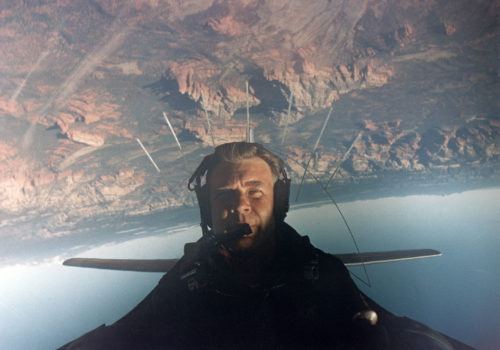For the 1956 Jet Age issue of Life magazine, I wanted to photograph the afterburners of some fighter jets going into the sunset—three red balls up here and one red ball down there. I thought that would be terrific. I was with a not-too-experienced pilot. We got up to 41,000 feet, and the canopy blew. It’s a phenomenon called explosive decompression, where the canopy actually is stressed to the point where it explodes. You lose the antenna, which is on top of the canopy. I could no longer communicate with the pilot, and he couldn’t communicate with me.
My mask blew off. He put the plane in a steep dive to get down. He put the air brakes down, and the plane just started to shudder. I had an option to grab the handle and get out of there. Explosive ejection of the seat is what you’re told to do, and then free fall till you get lower because you can’t breathe at 40,000 feet. You can’t live up there too long. Every piece of your skin feels like there are millions of needles pricking you as the oxygen bubbles up out of your blood. It’s quite an experience.
I couldn’t talk to the pilot, and anyhow he was too busy trying to keep control of the aircraft in this tremendous buffeting and shuddering. I thought I might as well die crashing as die ejecting. We were pretty much over the runway. They were launching night flights of inexperienced pilots. We couldn’t communicate, and yet we had to get down. The tower was furious because we were coming around the field for a landing. They were sending up red flares meaning, “You can’t land.” In the meantime, my pilot’s scared stiff. Life magazine is in the backseat. He doesn’t know if I’m alive or dead. He doesn’t want to get all the publicity connected with this one. Finally, the tower saw that we were going to come through, so they stopped the ground operations. We came down, and an ambulance and a staff car came running up to us and saw a plane without a canopy. They took us to a hospital. We overnighted, but fortunately we hadn’t suffered enough exposure to cold and lack of oxygen to be seriously hurt.
I didn’t make a big deal out of it until I got to New York and the film was developed. Life had a meeting to assess what do we do now with this story. Should we go on with it? At this meeting I remember finding out somehow that they really planned was to take my film and give it to an artist to use as reference to make paintings. They looked at the film. I said, “I didn’t tell you this before, but several nights ago, I had a little bit of trouble doing this thing.” I told them about it.
I said, “I just want to tell you that I don’t want any artist in a pink button-down collar taking these pictures and using them to make drawings from them.” They looked at me, and I guess the story of explosive decompression had gotten to them. The editor asked the art director, “Have you committed?”
“I got a guy in mind. I told him about it,” he said.
The editor said, “Let’s let Howard go ahead and see if we can’t do this in photography. It’s real, and it looks good. He’s got some pretty interesting stuff here.”
The art director said, sure. And walked out.
(Interviewed on October 28, 1993. Excerpted from: John Loengard, LIFE Photographers: What They Saw, Boston, A Bullfinch Press Book, 1998)
















